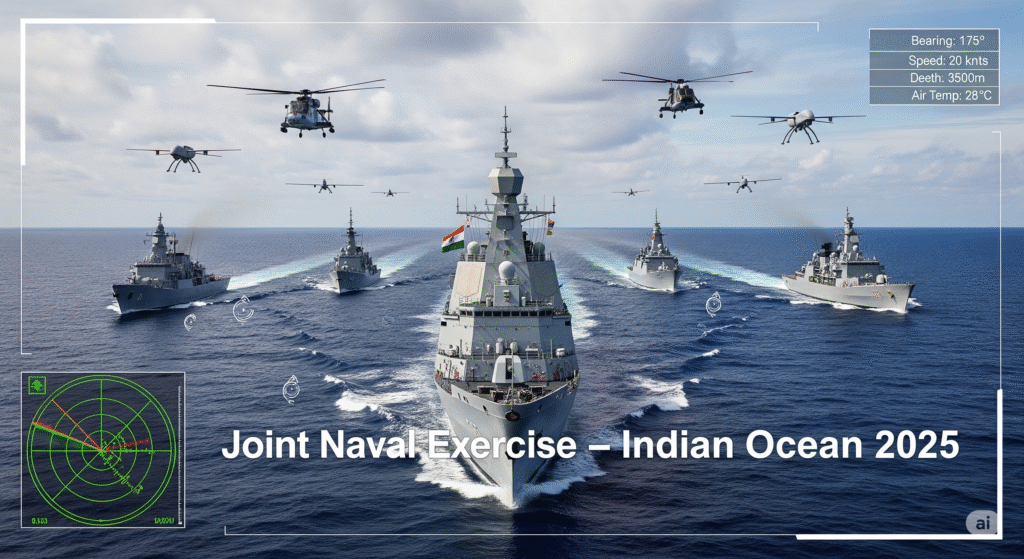India’s Naval Anti-Ship Missile (NASM) Program: Dominating the Indian Ocean by 2029
Strategic Imperative: Securing the IOR
The NASM program, launched in 2021, responds to escalating threats in the IOR. Operation Sindoor exposed Pakistan’s reliance on Chinese-supplied frigates and drones, neutralized by BrahMos but requiring longer-range, stealthier solutions to target Hangor-class submarines. China’s PLAN, with 3 aircraft carriers and 70+ warships by 2025, poses a greater challenge, deploying Type 055 destroyers along the LAC’s maritime flank. The NASM, with its sea-skimming profile and multi-platform launch capability, ensures India can strike high-value targets like PLAN’s Liaoning carrier from 800 km, outranging China’s YJ-21 missile.
Technical Prowess: Precision and Versatility
Developed with Bharat Dynamics Limited (BDL) and L&T, the NASM features a ramjet engine for Mach 2.5-3 speeds, a low radar cross-section (RCS ~0.15 m²), and dual-mode guidance (INS/GPS + active radar seeker) for 95% accuracy against moving ships. Its sea-skimming trajectory (5-10m altitude) evades CIWS like China’s Type 730. The July 2025 test from INS Chennai validated a 600 km strike on a target barge, with air-launched variants planned for Rafale-M and Tejas-N by 2028.
| Feature | Specification/Details |
|---|---|
| Range | 400-800 km |
| Speed | Mach 2.5-3 (3,000-3,700 km/h) |
| Payload | 200 kg (HE/penetrator warhead) |
| Guidance | INS/GPS + active radar seeker |
| Indigenous Content | 85% (BDL, L&T, DRDO) |
| Launch Platform | Ship (INS Vikrant, destroyers), air (Rafale-M, Tejas-N) |
| Deployment | 4 squadrons by 2029 (IOR, Andaman) |
| Cost | ₹12,000 Cr for Phase 1 |
Integration with Akashteer’s AI-driven Battle Management System and LODN’s 250 km optical detection ensures real-time targeting, while synergy with Project Kusha and S-400 protects naval assets from counterstrikes.
Strategic Impact: Maritime Deterrence
Operation Sindoor’s coastal strikes highlighted the IAF-Navy synergy, but Pakistan’s $1.5 billion Hangor-class submarines and China’s 60+ submarine fleet demand extended reach. The NASM’s 800 km range allows strikes from Andaman bases to Malacca Strait, choking PLAN’s supply lines. Its cost-effectiveness—50% cheaper than US Harpoon—enhances export potential to Vietnam and Philippines, strengthening QUAD’s IOR strategy. The program creates 10,000 jobs in Chennai and Hyderabad, boosting MSMEs like Tata Advanced Systems. It aligns with India’s hypersonic missile program for a multi-domain offensive edge.
Challenges and Future Horizons
Scaling ramjet production and integrating air-launched variants for Tejas-N remain hurdles, with 2027 trials planned for INS Vikrant compatibility. Delays in high-altitude testing could push timelines, but DRDO’s partnership with IIT Bombay mitigates risks. By 2030, a hypersonic NASM variant will complement Directed Energy Weapons (DEWs), ensuring IOR supremacy. As Navy chief Admiral Dinesh Tripathi noted in his October 2025 Kochi address, “Maritime power is India’s destiny”—a vision the NASM program advances.
Explore More:
Zorawar Light Tank for High-Altitude Warfare – Ground defence for border security.
India-UK £350M Missile Deal – Enhancing multi-layered defence.
Post-Op Sindoor: Pakistan’s Underground Airbases – Context for maritime threats.
DRDO’s LODN Stealth Detection – Optical synergy for targeting.
S-400 Upgrades – Complementary air defence network.
Project Kusha – India’s SAM for multi-layered defence.
Hypersonic Missile Program – Strategic offensive synergy.
Akashteer System – Networked command for maritime defence.
Sources: Consolidated from IDRW, NDTV, DRDO, and ORF as of October 13, 2025.
DefenceNiti.com: Empowering India’s Defence Awareness | #NASM #AtmanirbharBharat #IndianNavy



